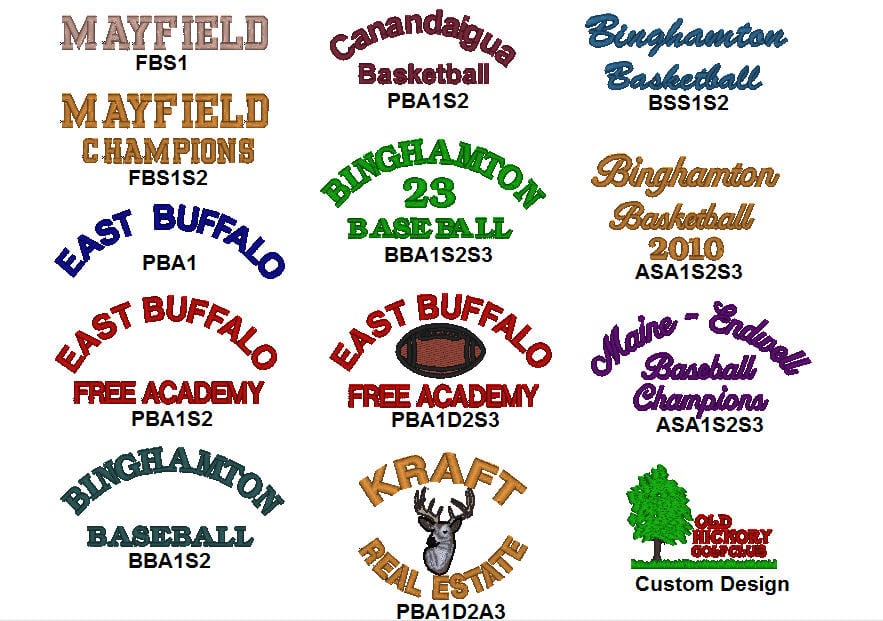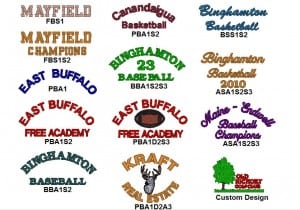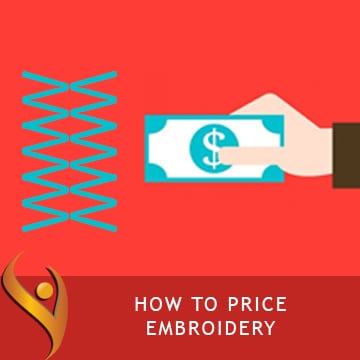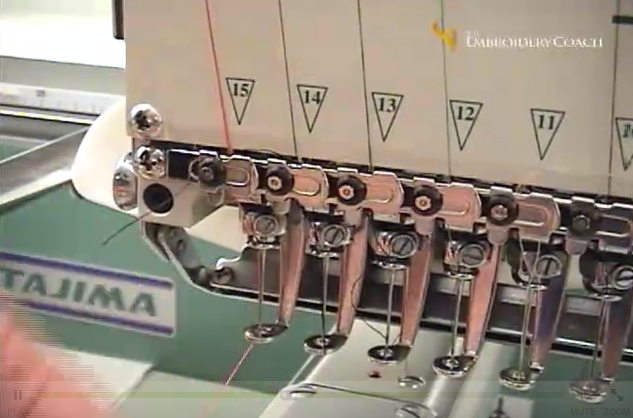
by The Embroidery Coach | | Embroidery Business Planning, Embroidery Production, Organizing
Saving time – Helping customers make quick ordering decisions can sometimes be very frustrating. Is your customer ordering process taking you too much time away from your production time? I want to talk about how you can cut back on the amount of time that it takes you to help your customers make a final decision.
As embroiderers we want to be able to offer our customers a full range of lettering and design options but in the process of doing so, we sometimes have the tendency to over complicate the process causing us and the customers unneeded frustration. There are 4 simple ways that will help to save time and speed up your customers ordering process.
- Embroidery Design Layout Options
- Limited Lettering Style Options
- Samples Tagged With Ordering Information
- Organized Ordering System
Today we will talk about the first in this series, the Design Layout Options.
Embroidery Design Layout Options
 Create several Design Layouts Options for your customer to choose from. By giving your customer choices of different layouts for him to look at before he places his order, you prevent him from asking you to create his logo with several different options for his approval.
Create several Design Layouts Options for your customer to choose from. By giving your customer choices of different layouts for him to look at before he places his order, you prevent him from asking you to create his logo with several different options for his approval.
These Design Layout Options save time and instills confidence in the customer that you know what you are doing and know what will be the best option for him or his logo.
Create Design Layout Sheets with several design templates that you have you already set up in your embroidery design software. Give each one of these design templates a Style No. When the customer orders a specific style no. you can quickly recall the design template from your system that he has ordered, change the lettering to what he or she is asking for and your design is ready to be sewn out.
You can create two sets of identical design templates, one set to be sewn on woven fabrics and one set to be sewn on knit fabrics. These two sets of Design Layout templates will work for 95% of your customers garment or fabric choices.
Click on the picture and you will see a larger view of the Design Layout Options
Helping customers make quick ordering decisions helps your business in several ways!
- You look more professional
- It save a lot of your time and the customers time
- You have more time for production
- You will bring in a lot more revenue!
In Part 2 of this series, I will talk about Limiting Lettering Style Options.
Joyce Jagger
The Embroidery Coach

by The Embroidery Coach | | Embroidery Business Marketing
Recently, I was working with one of my Lifetime Students that was not sure how to price her embroidery. She had the misconception that the proven embroidery pricing program that I have created was not for her. She was a home embroiderer and thought that this program and the way that I teach you was only for big businesses! I was shocked! Do you feel like learning how to price your embroidery correctly seems to be too difficult or more advanced than what you feel you are ready for?
If that is the case, let me simplify this! Pricing your embroidery correctly, so that you can make a profit and not work quite so hard is comprised of 7 basic things.
- How much money you need to be bringing in every single day and then each hour of the day to pay all of the bills and give yourself a salary=Cost per hour
- Break this cost down into minutes
- How long each process in your business takes in minutes
- Knowing how much each process costs based on your minutes cost=Cost per process
- How long it takes to complete a job, from start to finish.
- What was that total cost?
- How much do you want to mark up your cost? (Min. 25%, I highly recommend 50 to 100% depending on the type of customer)
Basically, that is the total formula. Now that being said, it does not matter how long you have been in business, at what level of business you are, how many embroidery heads you have, whether you work from home or have a storefront, whether you have employees or not, whether you paid cash for your machine or borrowed the money. None of that matters. It all works the same.
Learning to price your embroidery is not difficult, but pricing must be done correctly so that you can in fact make a profit. but you may need some guidance in your circumstances to make it easier.
To make it easy, go to https://howtopriceembroidery.com. This simple program that will help you get your pricing together very easily. All you have to do is add your expenses and it will create your price list for you! Go to: https://HowToPriceEmbroidery.com You will be glad you checked it out!
by The Embroidery Coach | | Embroidery Tip
This embroidery tip is all about quoting embroidery designs for your customer while they wait? Do you ever have a customer that brings in designs that they want you to reproduce? Of course, you do. Do they want a price while they wait? Sure they do. Have you ever wondered how you can be quoting embroidery designs for your customer without having to go to your digitizer to find out how many stitches there would be in that design?
I came up with a system that is fairly simple for quoting embroidery designs and it works great for me and has worked for the past 20 years. I started creating my system by typing in letters at different sizes into my digitizing system to find out what the stitch count would be. Of course, each style is a little bit different but for the most part, it worked. I averaged out the different letters and here is my result.
- 1/4″ letter = 150 stitches
- 1/2″ letter = 200 stitches
- 3/4″ letter = 350 stitches
- 1″ letter = 500 stitches
- 1 1/4″ letter = 600 stitches
These are the sizes that I have always used the most. If you add up all of the letters in the design by the size and multiply them by the number of stitches, you will have the stitch count for the lettering.
To figure the other areas in a design, there are approximately 1600 fill stitches in a square inch. These of course vary with the pattern and length of your stitch, but this is an average.
Satin borders are approximately 175 stitches per inch. This again is an average, it depends on the density of your stitch. You must also remember to add a little extra for underlay stitching but this will at least give you a starting point and it will make it much easier to look at a design and give a quick quote while the customer waits!
Do you have a method for quoting embroidery designs that you have used that has worked great for you? I would love to hear about it! You can learn more about quoting embroidery designs at the Embroidery Business Academy.
Joyce Jagger
The Embroidery Coach
by The Embroidery Coach | | Embroidery Production
In our last article about where to start training a new embroidery employee, I talked about starting them with the finishing process and then moving them into the helper’s position as soon as they were ready. Make sure that they totally understand each and every process along the way before they are moved into the next position. You must test them to make sure that you know they understand. This may sound very elementary but just asking them is not good enough. YOU MUST KNOW!
In step one of the previous article, we went over putting new cones of thread onto the machine and learning how to tie a Weaver's knot. I gave you a video showing you a simple way to do this. Having a helper change thread colors saves the operator a lot of production time. Have them do the thread-changing process over and over until they have it mastered. As I said before, this sounds so simple that anyone should be able to immediately do it. Do not assume that. Once again, do not let them go to step two until step one is mastered.
Thorough Training Of The Embroidery Machine Helper is Very Important!
A helper is someone that will tie new thread cones onto the machine, help load and unload the machine, carry work from the hooping area to the machine, and carry the finished work from the machine to the trimmers. Their main purpose is to keep the operator focused on keeping the machine running as much as possible. The training of this new embroidery employee helper is important for maximizing your production. Make sure that they understand exactly how and why each step of the process is done a certain way. Now we are ready for Step two in the process of training the new helper.
Step two- Teach them how to unload the machine without getting anything caught or snagged by the needles. Teach them how to remove the hoop without touching the needles. This will dull the needles. Show them how to remove the hoop from the garment as they unload the machine and place both the unhooped garments and the hoops in their correct locations. Do not let them go to step three until step two is mastered.
Step three- Teach them how to load the machine without getting any of the garments caught under the presser foot or trapped between the bottom of the hoop and the throat or needle plate. This is especially important when loading tubular-style machines. Show them how to run their hands under the garment to make sure that nothing is caught. Teach them not to touch the needles with the hoop as they are loading the machine. This will dull the needles.
These are basic skills that need to be mastered by everyone on the production floor. This includes the trimmers, hoopers, packers, steamers, as well as the machine operators. This helps everyone to know what the whole process is and also gives you skilled people to use if you need to pull them from another position to help out temporarily.
Give New Embroidery Employee Copy of Training Manual
Give the new Embroidery employee a copy of the training manual that is applicable to their position which explains all of the processes that they will be expected to perform. They should be tested at the end of each training period to see if they have indeed mastered all of the skills that are required. It is too often taken for granted that the new person knows exactly what to do after they have been shown a couple of times. This is not the case as a general rule. Some people learn faster than others. Just because a person has not learned as quickly as you, or as quickly as you have expected them to, does not mean that they are not qualified to be a good worker.
Helper Makes It Possible For The Embroidery Machine Operator To Produce More!
If a person has mastered the skills of a helper but cannot go on from there, that is OK. They can remain a helper and be extremely valuable in that position. This helper makes it possible for the machine operator to get much more production done at day's end.
Make sure that your machine operators treat these new employees with the same respect that they want to be treated with. This is not always the case. They very often expect too much too soon. Keep the lines of communication wide open between the new employee, the older employee, the supervisor, and you. Everyone needs to be made to feel important in their position. You do not want any resentment, jealousy, or dissension building up between anyone in the organization. This needs to be emphasized from Day 1 with any new embroidery employee!

by The Embroidery Coach | | Embroidery Production
As a small embroidery shop owner, have you ever had a situation where you needed to train a new embroidery production employee but really had no idea where to start? This can be very frustrating for the small embroidery shop owner that has always worked alone and has never had to teach anyone how to efficiently help them.
In this article, I will start with the very first employee that a small embroidery shop owner should start training for the embroidery production floor.
Start The Training Of A New Embroidery Production Employee With The Final Process – Finishing!
If you have hired a new employee for the production floor, the best place to start them is with the finishing process. Regardless of what you have hired them for, start them trimming, folding, and packing. This helps them to see how the process is completed and gets them excited to learn more. If a new employee cannot trim, they need to be dismissed. This is a very basic function but takes dexterity and attention to detail. Many people feel that this part of the process is for low paying individuals that cannot do anything else. This could not be farther from the truth. A trimming mistake can ruin the entire process if close attention is not paid to detail. They need to have a positive attitude, and their attitude will really show up during this process.
How To Start Training A Production Helper
Once the new person has learned the finishing process, they can then be moved into a helper’s position. A helper is someone that can tie new threads onto the machine, load and unload the machine, carry work from the hooping area to the machine and carry the finished work from the machine to the trimmers. The training of this helper is very important. They must be shown everything that they are supposed to do and be thoroughly tested on these skills. This may seem like it is so simple that anyone should be able to do it, but they still need to be taught exactly how each step is done.
Step One – Show them where the threads are stored and how you put them onto the machine. Teach them how to do the Weavers knot so that the threads will pull right through the needle eyes. Have them do it over and over until they have it mastered. Make sure that they understand exactly how and why each step of the process is done the way it is. Do not let them go to step two until step one is mastered.
Here is a video showing you how to tie the Embroidery Threads so that they will go right through the needles! It works 99% of the time. Huge time-saver!
Proper training is extremely important when you hire a new employee for your embroidery operation. Without the proper training this new employee can end up creating a lot of mistakes which will lead to lost production. This is just as important for the small embroidery shop owner that is hiring their first employee as it is to the multi-head shop that has many employees. Learning the right process to train a new embroidery production employee is very important. It is going to mean the difference between a well-run shop and one that is only mediocre. You want to make sure when you train a new embroidery production employee that everyone is on the same page, so to speak!

 Create several Design Layouts Options for your customer to choose from. By giving your customer choices of different layouts for him to look at before he places his order, you prevent him from asking you to create his logo with several different options for his approval.
Create several Design Layouts Options for your customer to choose from. By giving your customer choices of different layouts for him to look at before he places his order, you prevent him from asking you to create his logo with several different options for his approval.

